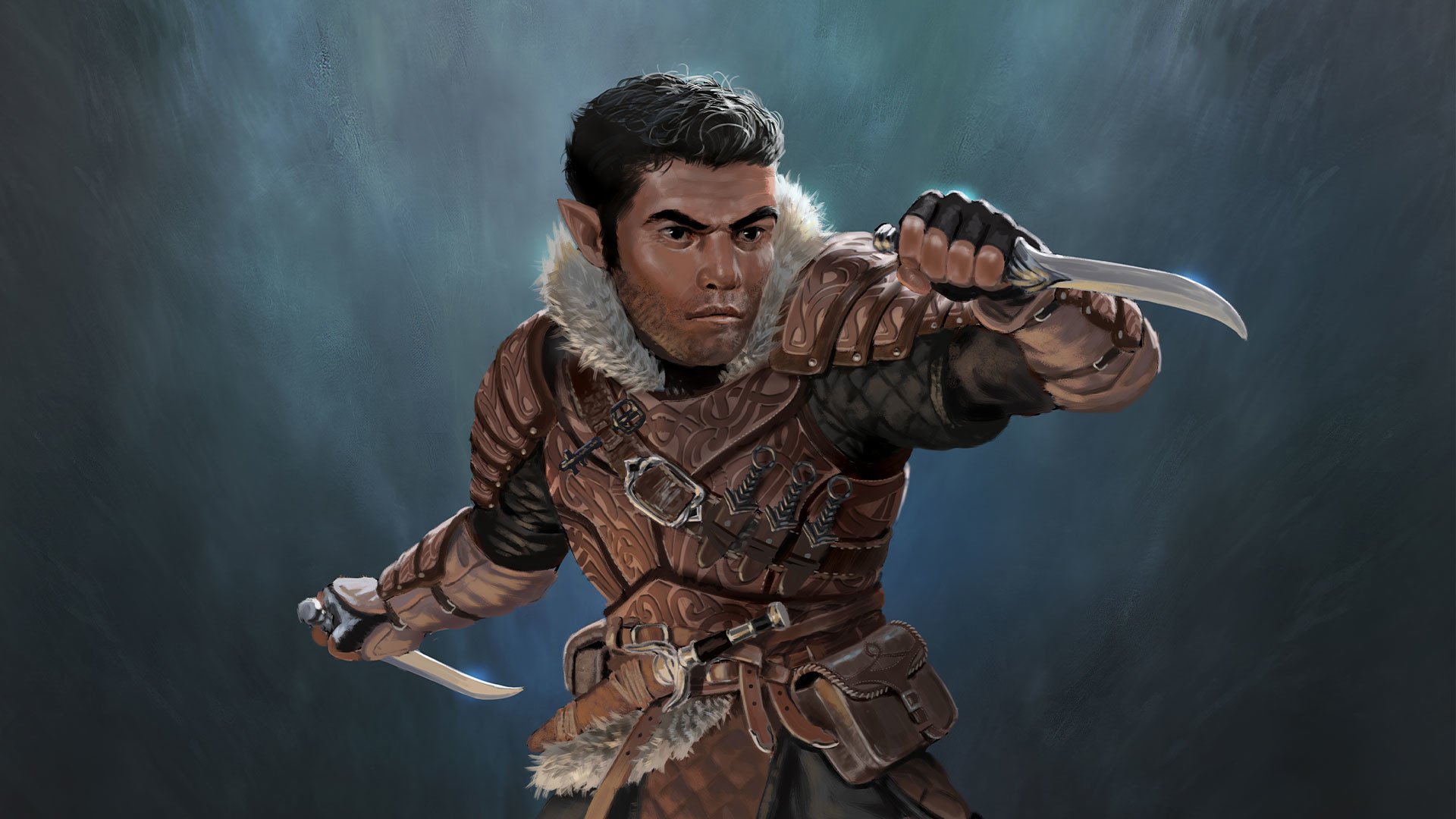Hello there fine folks,
Who here loves playing Rogues? Fail their Stealth roll at the worst time? Fumble their Sleight of Hand check putting themselves in a very awkward situation? No one? Okay maybe I’m not selling the class very well. For every Rogue out there low rolling on their Sneak Attack damage, there’s another throwing a bucket of dice thanks to a crit (more. MORE!) - and good lord does that feel good, am I right fellow dice goblins? No, just me?
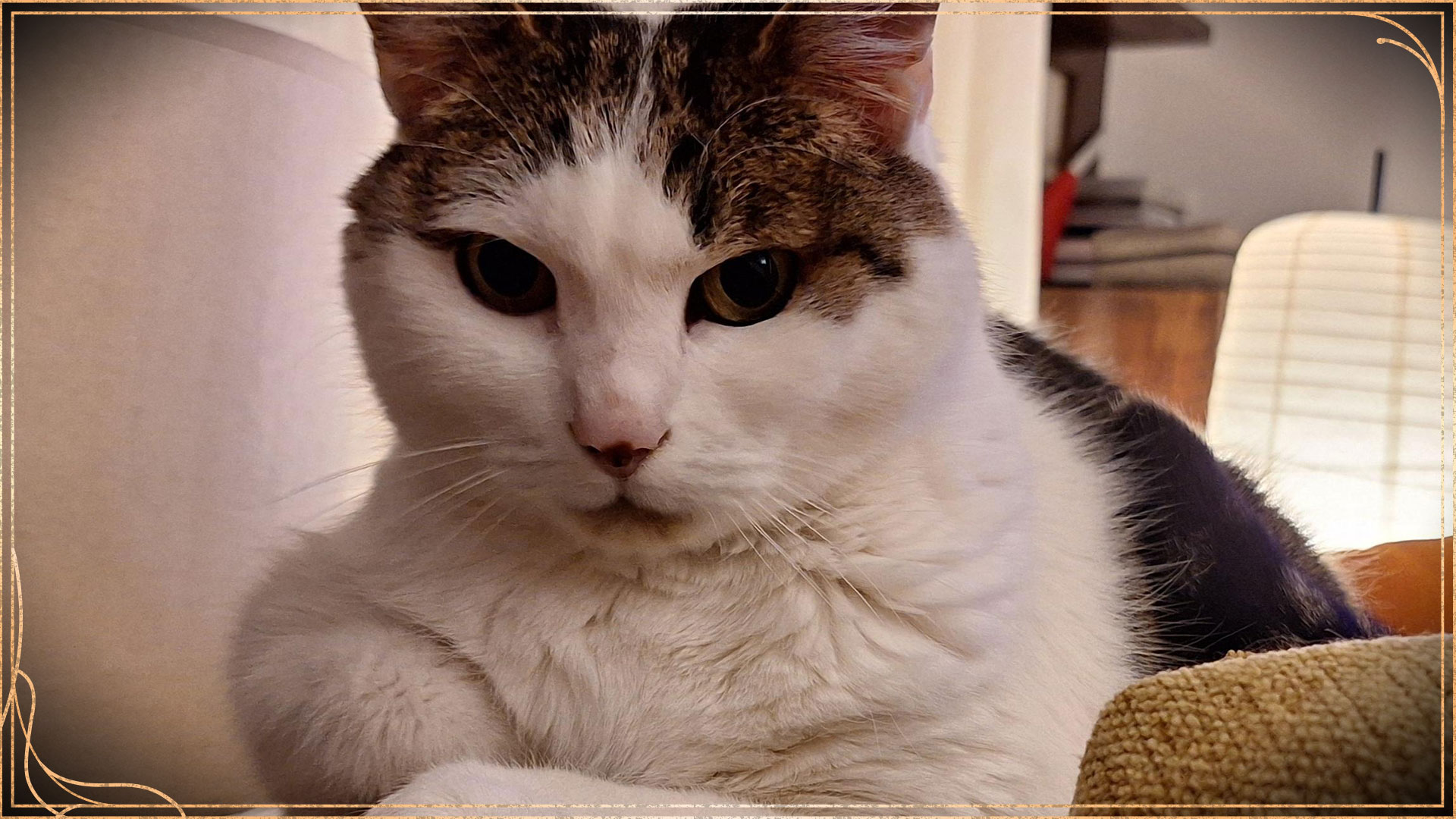 Sherlock knows you’re lying. Everyone loves rolling dice. More dice is more fun. It’s not me having a problem.
Sherlock knows you’re lying. Everyone loves rolling dice. More dice is more fun. It’s not me having a problem.
Before we start, don't forget to wishlist Solasta II on Steam - it helps us a ton!
They see me stabbin'
If there is one thing the Rogue is known for, it’s their signature Sneak Attack. As long as you have advantage on your attack or a (still very much conscious) friend nearby, you’re doing damage baby! Roll them damage dice!
The Rogue is also a slippery fellow with Cunning Action, which makes them one of the rare classes who can attack and get out in the same turn without getting slapped back. If that doesn’t sound fair, it’s because it isn’t - fighting fair is for LOSERS.
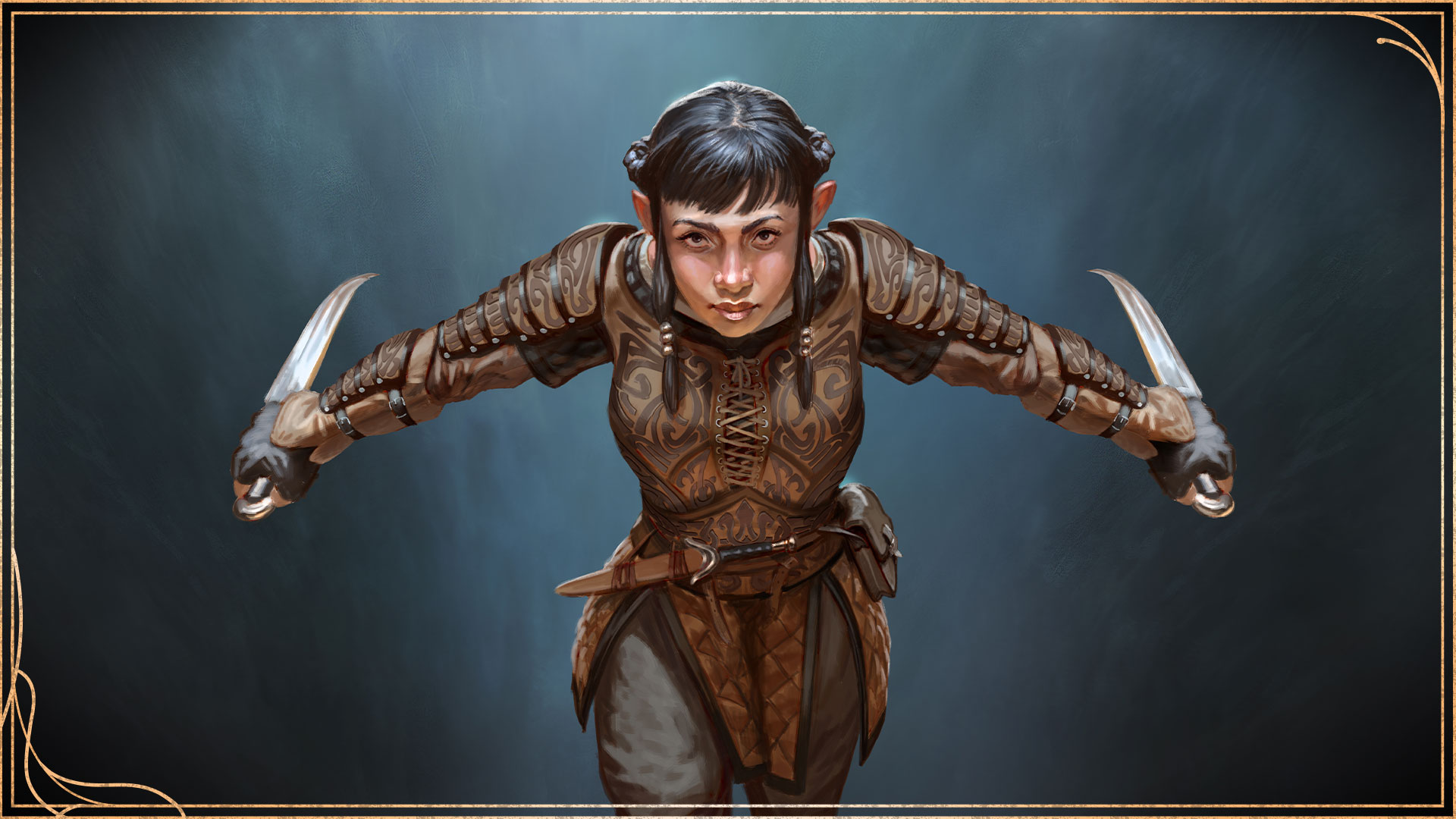 Only thing that matters is who’s alive at the end, eh? No hard feelings.
Only thing that matters is who’s alive at the end, eh? No hard feelings.
The last thing Rogues are well known for is their versatility. They not only get plenty of skill proficiencies to climb, run, sing or even think better, they even get expertise to get an even better bonus. Yes sometimes that means you outsmart the 20 intelligence wizard at the spelling bee contest even though you should barely be literate, but hey that’s just how the game goes.
More likely though, you’ll be the one in the party sneaking around undetected, looking out for traps and opening locked doors and chests. You’ll be the one who “knows a guy” to get your friends to places you’re trying to go. You’ll be the one stabbing that smug gloating villain when and where they least expect it, and you’ll make it hurt.
The Rogues of Solasta
You thought just because you’re a D&D expert we wouldn’t have anything for you today? Wrong, my friend! And that’s not because I artificially increased the Investigation DC to 35 for you to fail (which I totally did not do, nuh uh).
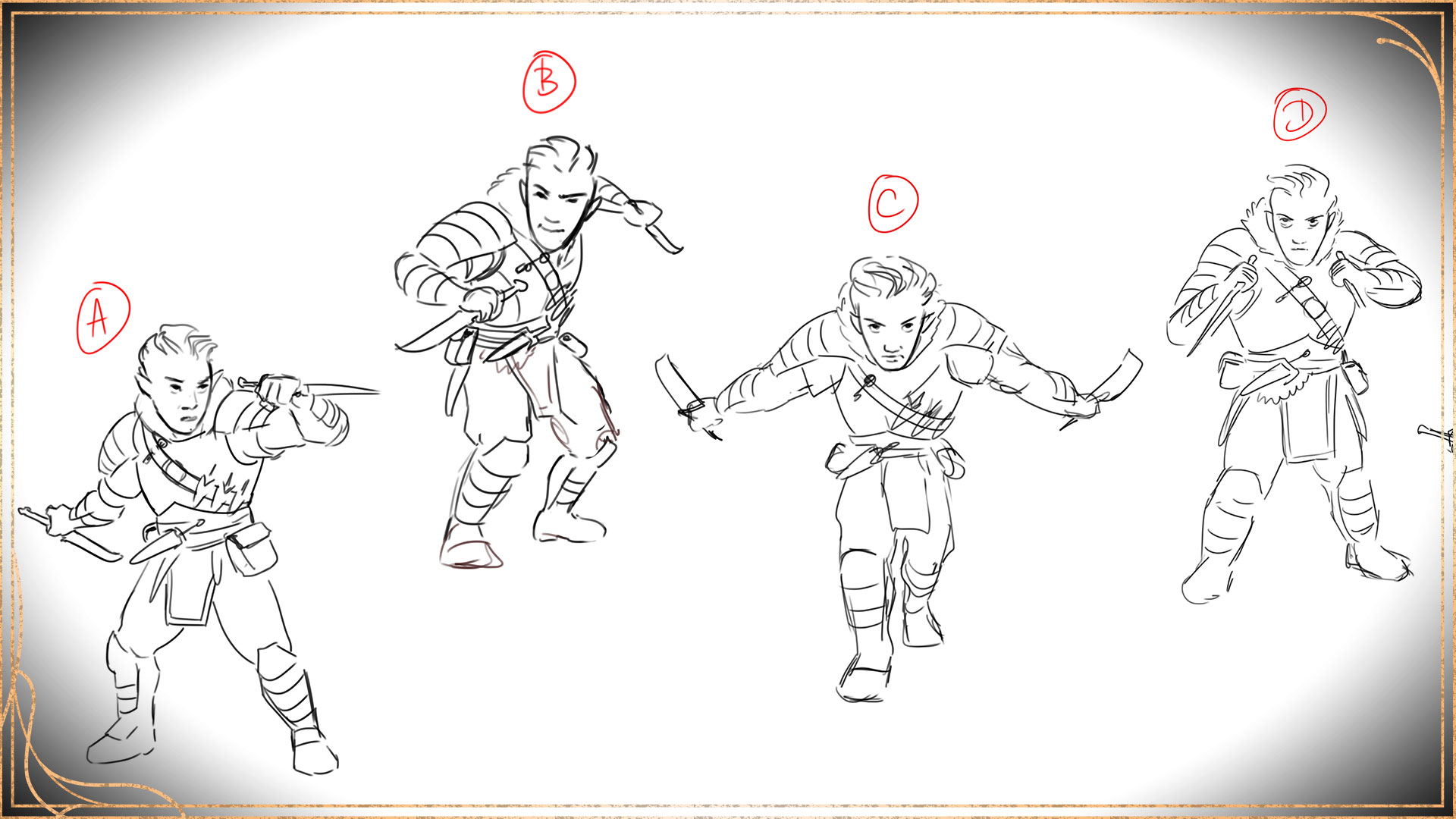 I mean aside from all the cool Rogue-related concept art and research doodles you get to see, like this one to select a pose for the character.
I mean aside from all the cool Rogue-related concept art and research doodles you get to see, like this one to select a pose for the character.
For you long-time players, we’re offering our very own retrospective on the subclasses of Solasta I. It’s been a few years - what do we as developers think of them?
Before we start, just a small reminder that our current goal is to attempt and implement all 12 classes for Solasta II 1.0 release, with each class getting 2 subclasses - one from Solasta I, and one new from the continent of Neokos. It’s important to keep in mind that we are not certain yet if we will be able to achieve that (budget / time constraints), but it’s very much something that we want to have if we can.
The Thief (SRD)
Let’s be honest, the Thief was mostly there because we decided early on during Solasta I’s developpement that we would have all SRD subclasses. It ended up being… not that well suited for Solasta I, mostly because its features aren’t centered around combat when our game was very much about combat.
You mostly get to climb faster and sneak better - and while its defining feature allowing you to use items as a Bonus Action instead of an Action is good, it’s limited by what items exist in Solasta I (compared to your vast imagination on Tabletop).
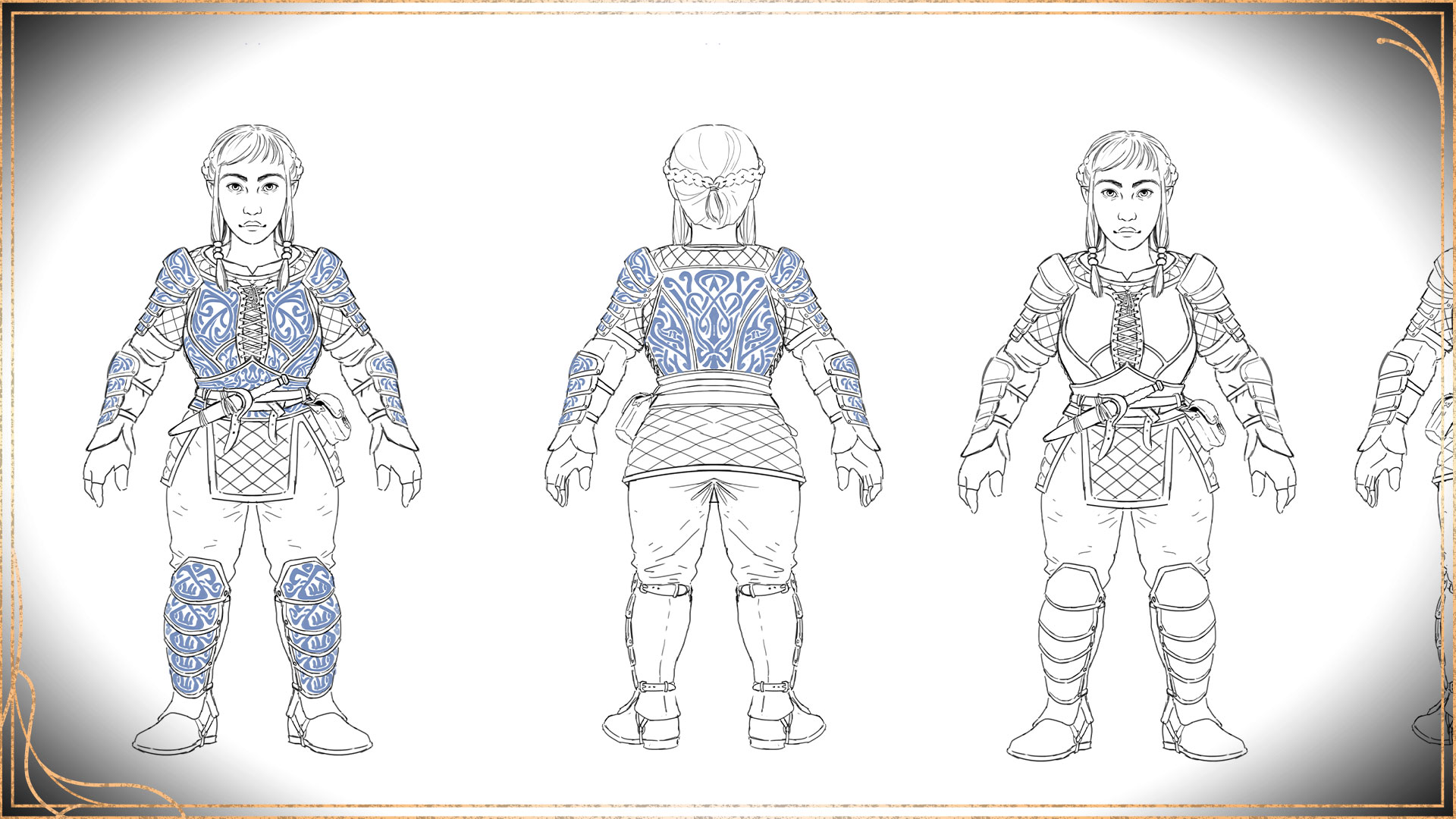 And you get to wear a fancy leather armor while doing so! Well okay every rogue gets to wear fancy leather armors.
And you get to wear a fancy leather armor while doing so! Well okay every rogue gets to wear fancy leather armors.
One really fun thing the Thief got in Solasta was that they were able to use all magic items without restrictions, allowing for some fantastic utility… but it only came at level 13. Plus when you take into account the fact that most powerful items need attunement, you’re still limited to 3 slots in the end. Damn!
Final verdict? It was just not that great of a fit in Solasta I, but we probably couldn’t have done things much differently for the Thief due to it being SRD and us wanting to keep it faithful to the tabletop version.
The Darkweaver (Crown of the Magister)
Oh boy, what a mess the Darkweaver was! As the name implies, it was themed around spiders, meaning it had something to do with poison and climbing - and honestly, that sounds pretty cool on paper! Poison is something that’s not very well explored in 5e so we could build on that, and climbing goes perfectly with Solasta’s verticality! Problem is… while it was thematically sound, its features were all over the place and didn’t really do much for you.
You were proficient with the Poisoner’s Kit, which could be achieved by simply selecting a background. Climbing didn’t cost you extra movement - but hey, Thief got that too. You can climb difficult terrain surfaces… but what is a difficult terrain surface? Attacking enemies who are below you gives you bonus damage equal to your proficiency, but Rogues synergize with more dice rolls and not flat damage because they only attack once per turn. Your melee weapons (why melee? I thought you wanted to shoot arrows from above to get bonus damage?) became permanently coated in poison forcing a flat DC 13 (why flat DC?!) Constitution Saving Throw to avoid 2d6 extra poison damage and being poisoned for… one whole hour?! Finally, you could go invisible until the end of your turn using your Bonus Action when not in Bright Light and out of line-of-sight from all enemies… which you could more or less already do by using Cunning Action to stealth, which required the same prerequisites and didn’t dispel at the end of your turn.
Let’s be honest, the Darkweaver was far from our best work - in fact, it was one of the earliest ones when we did not yet take the proper time to sit down and think about how the whole kit would play out. Just to give a little more context: the earlier designed subclasses are generally the more messy ones, because the team was much smaller the amount of time one could allocate each of their tasks was very limited. And for the very same reason, once a feature was implemented we could rarely justify going back to change it (which would require us to code a completely new feature most of the time), instead of working on the rest of the game. So even if a subclass wasn’t great… as long as it worked, we kept it as is. You’re seeing the result of just that, a real piece of history frozen in time!
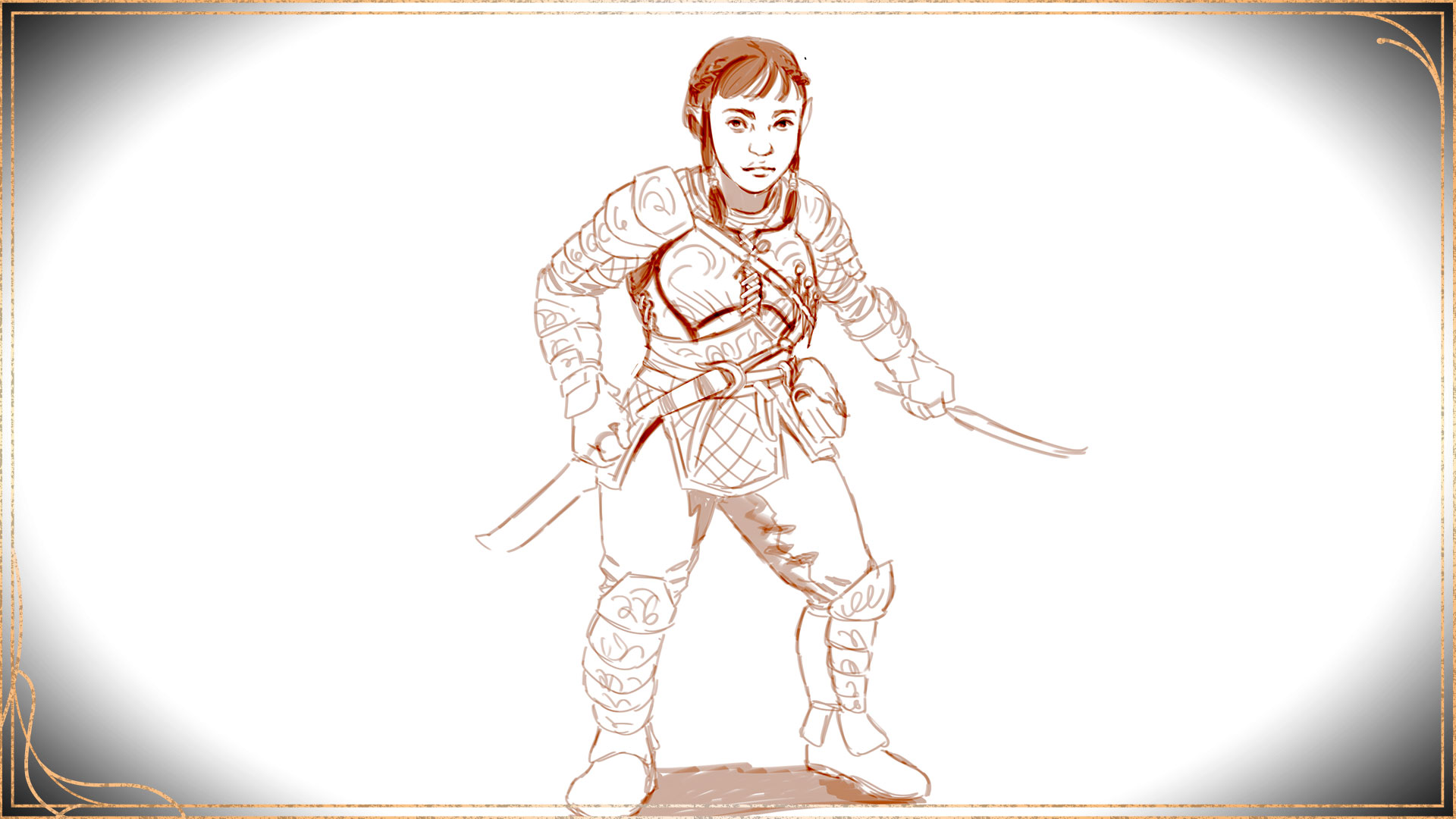 As much history as this premium doodle of a female halfling rogue!
As much history as this premium doodle of a female halfling rogue!
As you can see, the idea is here but the execution was lacking. Thematically the Darkweaver is pretty interesting - especially with how much Solasta made an emphasis on verticality. Being able to climb around, shoot and poison enemies. We reworked it pretty extensively in the Solasta Sourcebook to lean more into the poison fantasy and make its feature synergistic. For example, you now simply gained climbing speed, and attacking enemies below you triggered Sneak Attack instead of gaining flat damage. You also gained the ability to bypass poison resistance and partially negate poison immunity, which was the main reason why the “Poisoner” fantasy never really worked at higher level in D&D - with most creatures immune to poison. Granted that last one was a little controversial when we playtested it, because as far as I know nothing in the official rules can bypass immunity…
Final verdict? A funny window into the past, one that we can’t be too proud of but that reminds us of where we started from. And also the indication that as long the theme is solid, we could rework it to make it interesting. The Darkweaver is not very likely to be the subclass we choose to keep in Solasta II due to its reliance on specific vertical environments (like cavern walls) and poison (which is a system that is developed in the later stages), but we love it all the same.
The Shadowcaster (Crown of the Magister)
The Shadowcaster suffers from a few similar issues as the Darkweaver, being designed in the earliest days of Solasta I - but to a much lesser extent as it mostly relies on spellcasting, which is already well charted. The original idea was to have a more lethal version of the Arcane Trickster, less centered around the theme of subterfuge and misdirection and more about being a magically empowered assassin.
The challenge here was, of course, mostly trying to make it different enough from the official 5e Arcane Trickster, which ended up in the Shadowcaster getting access to… Divination, Illusion, Necromancy and Abjuration schools. Which, let's be honest, didn’t give them a great selection of spells for what they were intended to do.
Another limitation was that you couldn’t cast most spells while dual wielding, so it forced Shadowcasters into using bows. And until level 13, there wasn’t any great synergy between the fact that you were a Rogue and your ability to cast magic - before that you basically had a Misty Step on a short rest, and the ability to retaliate using a cantrip when enemies targeted you with magic. But the kit was already fairly solid, it only needed a little shaking up!
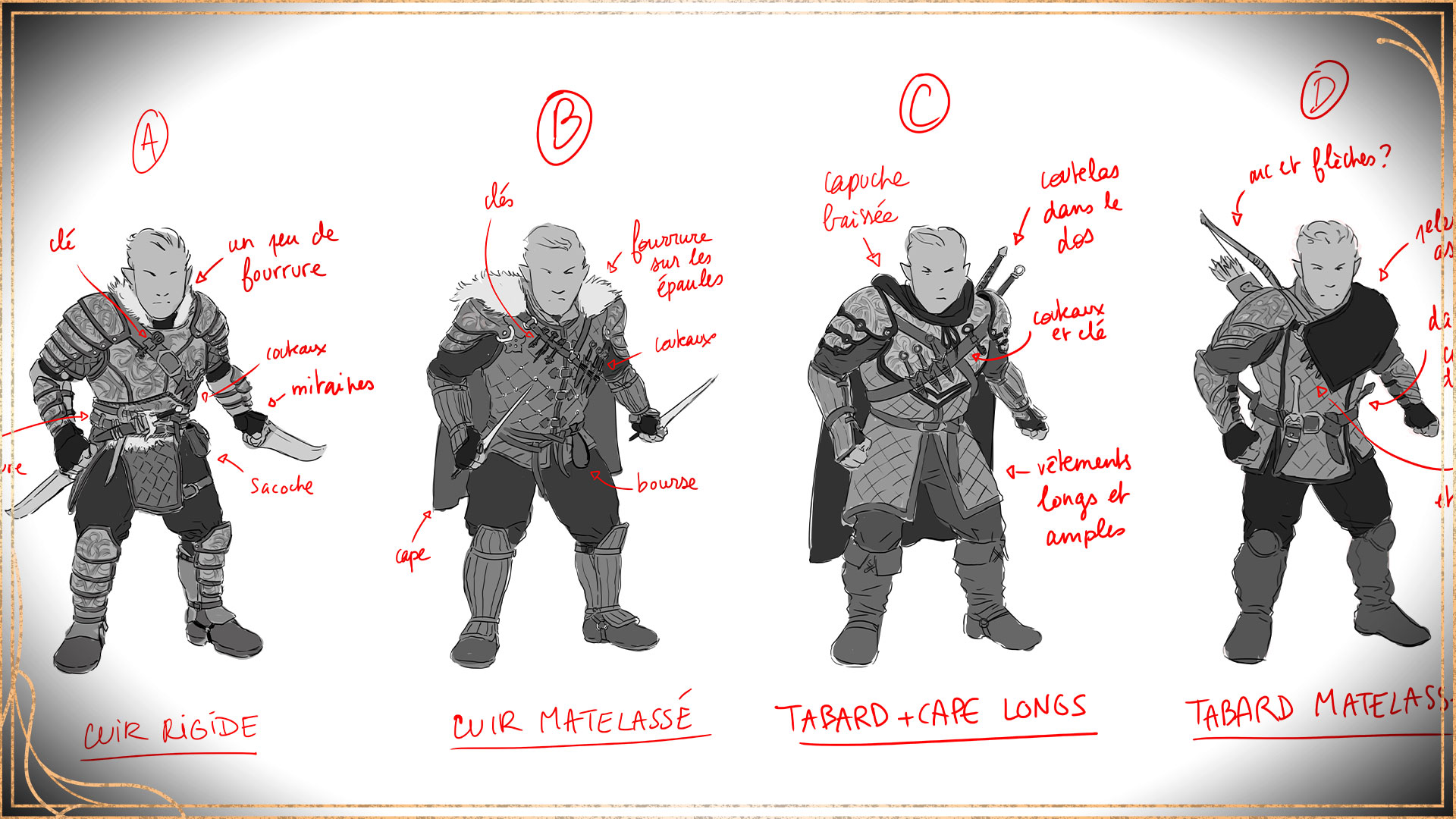 Let’s take a mandated break from all the reading with another bit of research on armor visuals. Options, options…
Let’s take a mandated break from all the reading with another bit of research on armor visuals. Options, options…
When we reworked it in the revised Sourcebook version, we changed it to the Conjuration, Evocation, Necromancy and Transmutation schools instead, greatly improving their spell list, and allowing them to Sneak Attack with attack spells at level 3 instead of 13 (thus making it the defining feature of the Shadowcaster). A fairly simple change, but one that brings out its identity right out of the gates.
Final Verdict? I think the Shadowcaster is interesting and always had potential, which we unfortunately didn’t manage to bring out straight from the start. It’s one of the more likely subclasses to appear in Solasta II, if we decide we want to include a spellcaster Rogue archetype.
The Hoodlum (Lost Valley)
The last of the four brothers and the biggest of the bunch, who joined the crew with the release of Lost Valley. The Hoodlum’s whole shtick was “what if the standard bully / brute henchman you’re used to meeting and beating up in the back alley became an actual archetype”? It is a result of Solasta I not having Multiclassing, which made us experiment with more hybrid subclasses - what about a Strength Rogue?
So it was born, able to sneak attack with non-finesse weapons, use medium armors, shields and martial weapons, giving enemies disadvantage when hitting them with a sneak attack, and getting a strange power to blind enemies which, let’s face it, is basically pocket sand.
This archetype came up later and stood fairly solid on its own, giving players an option to live a very different fantasy - play dirty and hit very hard with a single blow every turn - which many enjoyed, quite a bit. Which is not to say it was without flaws, with the biggest issue being that it fell into the design issue of “I have to know in advance that I’m going to make a Hoodlum Rogue”. You would usually dump Strength and stack Dexterity as a Rogue, but the Hoodlum made you want to have Strength to use all these non-finesse weapons, so you’d end up having to play a weird Strength Rogue at level 1 & 2 with no real synergy. And pocket sand, although funny and thematic of fighting dirty, is a little ridiculous - ideally we would have loved to have something else.
Final Verdict? Honestly, the Hoodlum fits a role - being able to Sneak Attack with non-finesse weapons is something unique to this archetype. However, in Solasta II classes will only have two subclasses at 1.0 launch, so is it a good idea to lock one archetype behind a weird Strength build when the vast majority of Rogues want to build Dexterity?
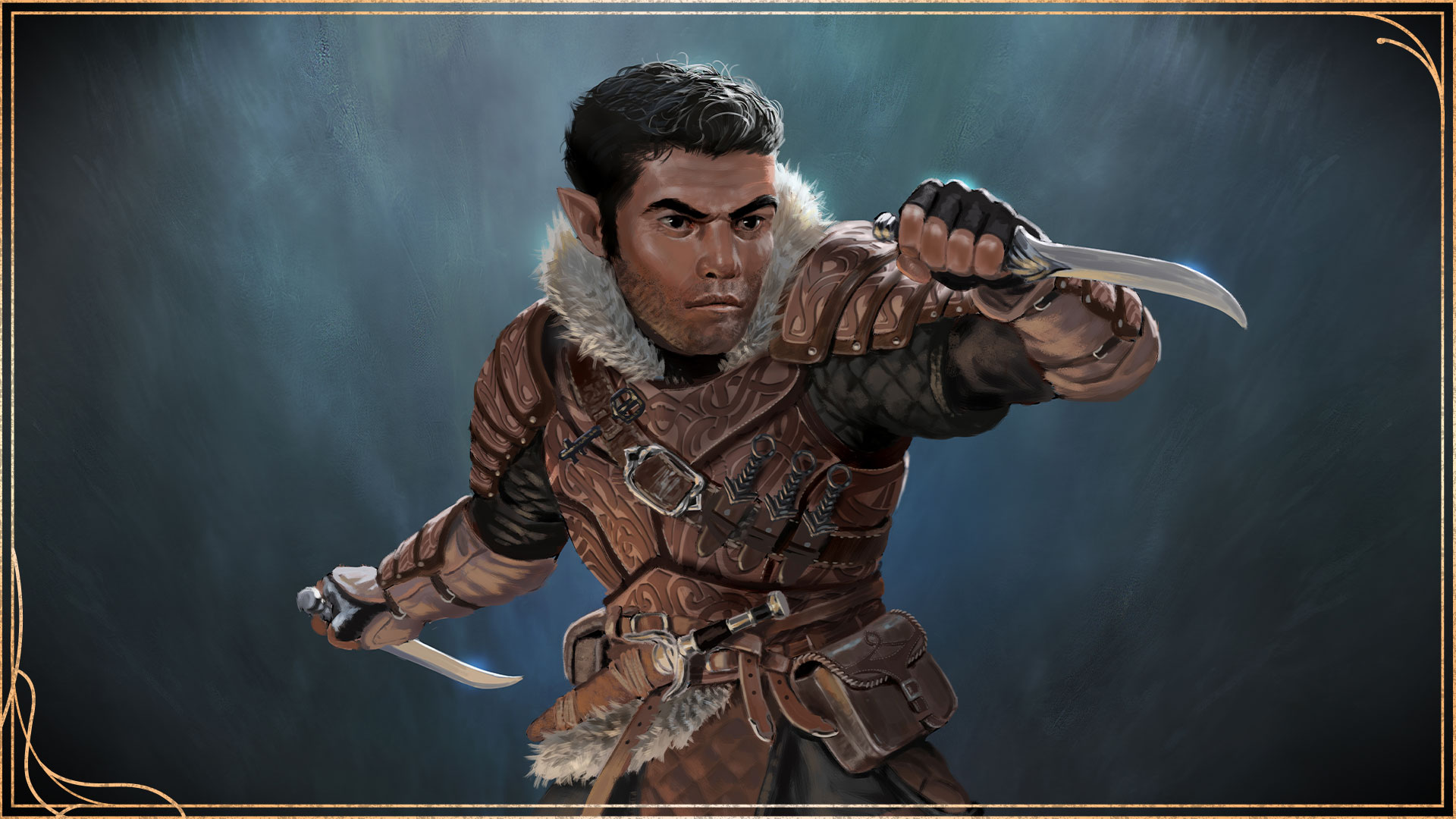 Maul-wielding rogues are fun and all, but they don’t necessarily appeal to the primary Rogue fantasy.
Maul-wielding rogues are fun and all, but they don’t necessarily appeal to the primary Rogue fantasy.
The… ??? (Solasta II)
Now I wouldn’t want to spoil the surprise too much. As stated before we are experimenting on new subclasses for Solasta II, and you will see some of them in the upcoming demo - although please keep in mind that they may yet change!
What do YOU think this new subclass’ theme will be?
Article by Tactical Myzzrym
Follow us on:
